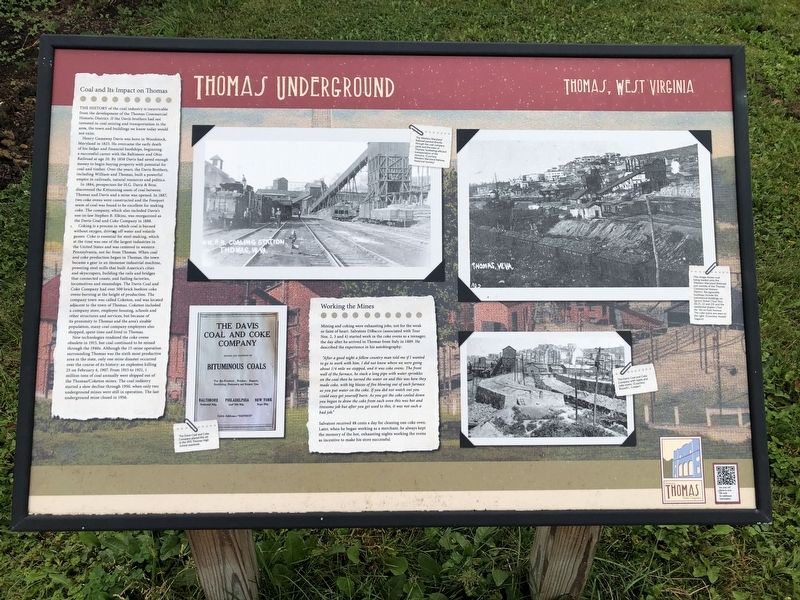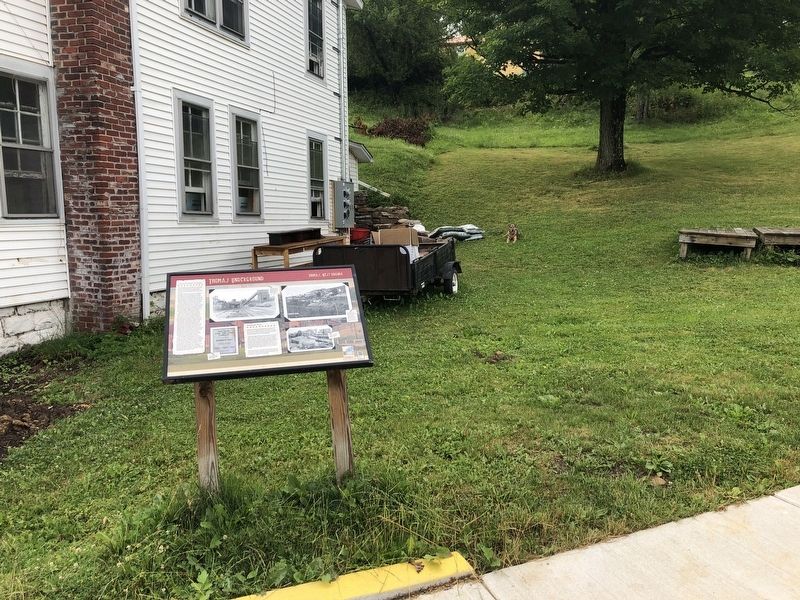Thomas in Tucker County, West Virginia — The American South (Appalachia)
Thomas Underground
Thomas, West Virginia
Coal and Its Impact on Thomas
The history of the coal industry is inextricable from the development of the Thomas Commercial Historic District. If the Davis brothers had not invested in coal mining and transportation in the area, the town and buildings we know today would not exist.
Henry Gassaway Davis was born in Woodstock, Maryland in 1823. He overcame the early death of his father and financial hardships, beginning a successful career with the Baltimore and Ohio Railroad at age 20. By the 1858 Davis had saved enough money to begin buying property with potential for coal and timber. Over the years, the Davis Brothers, including William and Thomas, built a powerful empire in railroads, natural resources and politics.
In 1884, prospectors for H.G. Davis & Bros. discovered the Kittanning seam of coal between Thomas and Davis and a mine was opened. In 1887, two coke ovens were constructed and the Freeport seam of coal was found to be excellent for making coke. The company, which also included Davis's son-in-law Stephen B. Elkins, was reorganized as the Davis Coal and Coke Company in 1888.
Coking is a process in which coal is burned without oxygen, driving off water and volatile gasses. Coke is essential for steel-making, which at the time was one of the largest industries in the United States and was centered in western Pennsylvania, not far from Thomas. When coal and coke production began in Thomas, the town became a gear in an immense industrial machine, powering steel mills that built America's cities and skyscrapers, building the rails and bridges that connected coasts, and fueling factories, locomotives and steamships. The Davis Coal and Coke Company had over 500 brick beehive coke ovens burning at the height of production. The company town was called Coketon, and was located adjacent to the town of Thomas. Coketon included a company store, employee housing, schools and other structures and services, but because of its proximity to Thomas and the area's sizeable population, many coal company employees also shopped, spent time and lived in Thomas.
New technologies rendered the coke ovens obsolete in 1915, but coal continued to be mined through the 1940s. Although the 15-mine operation surrounding Thomas was the sixth most productive area in the state, only one mine disaster occurred over the course of its history: an explosion killing 25 on February 4, 1907. From 1915 to 1921, 1 million tons of coal annually were shipped out of the Thomas/Coketon mines. The coal industry started a slow decline through 1950, when only two underground mines were still in operation. The last underground mine closed in 1956.
Working the Mines
Mining
"After a good night a fellow country man told me if I wanted to go work with him. I did not know where we were going about 1/4 mile we stopped, and it was coke ovens. The front wall of the furnace, he stack a long pipe with water sprinkles on the coal then he turned the water on and this was how they made coke, with big blazes of fire blowing out of each furnace as you put water on the coke. If you did not watch out you could easy get yourself burn. As you got the coke cooled down you began to draw the coke from each oven this was hot and tiresome job but after you get used to this, it was not such a bad job."
Salvatore received 48 cents a day for cleaning one coke oven. Later, when he began working as a merchant, he always kept the memory of the hot, exhausting nights working the ovens as incentive to make his store successful.
Erected by The City of Thomas, West Virginia.
Topics and series. This historical marker is listed in these topic lists: Industry & Commerce • Railroads & Streetcars. In addition, it is included in the Baltimore and Ohio Railroad (B&O), and the West Virginia, The City of Thomas series lists. A significant historical date for this entry is February 4, 1907.
Location. 39° 8.885′ N, 79° 29.958′ W. Marker is in Thomas, West Virginia, in Tucker County. Marker is on Appalachian Highway (West Virginia Route 32), in the median. Touch for map. Marker is at or near this postal address: 220 Appalachian Highway, Thomas WV 26292, United States of America. Touch for directions.
Other nearby markers. At least 8 other markers are within walking distance of this marker. "All that Humanity Could Desire…" (within shouting distance of this marker); Thomas, Yesterday and Today (about 300 feet away, measured in a direct line); Historic Thomas and the Coketon Industrial Complex / News Flash! (about 400 feet away); Exploring the Coketon Industrial Site / West Virginia Coal (about 400 feet away); The Story of a River / Life in a Coal Mining Town (about 400 feet away); Thomas, West Virginia Mine Disaster Memorial (about 600 feet away); Dwellings and Design (about 700 feet away); A Lesson in Resourcefulness (approx. 0.2 miles away). Touch for a list and map of all markers in Thomas.
Credits. This page was last revised on September 25, 2022. It was originally submitted on July 18, 2020, by Devry Becker Jones of Washington, District of Columbia. This page has been viewed 183 times since then and 23 times this year. Photos: 1, 2. submitted on July 18, 2020, by Devry Becker Jones of Washington, District of Columbia.

